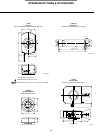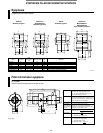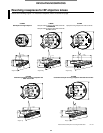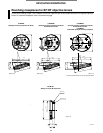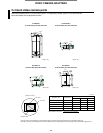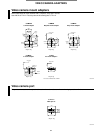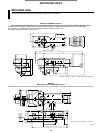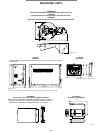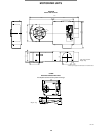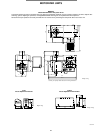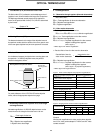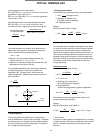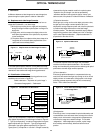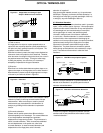
•Total magnification on the video monitor:
m(ob)=50×, M(video camera adapter) is 0.5× from Figure 1 and monitor
magnification is 46.2× from Figure 3.
M(monitor observation)=M(ob)×M(
video camera adapter
)×monitor magnification
=50×0.5×46.2=1155×
•Practical filed of view for video observation(horizontal side):
M(ob)=50×, M(video camera adapter) is 0.5× from Figure 1 and
horizontal side of 2/3" imaging device is 8.8mm from Figure 2
=
8.8 (mm)
=352µm
50 × 0.5
6. Numerical Aperture (N.A.)
The numerical aperture is a key factor to the performance of
objective lens (resolving power, focal depth and brightness).
The N.A. is determined by the following formula:
N.A.= n × sinθ
n=Refraction rate of the medium between specimen and
objective lenses. (Air: n=1, oil: n=1.515)
θ: Angle which is made by the optical axis and refraction of the
light farthest from the center of the lens.
The visual field brightness (B) of the microscope is determined
by the following formula in relation to the objective lens
magnification (M). The larger the N.A. and the lower the
objective magnification, brightness will increase in the factor of
the second power.
B
∝
N.A.
2
M
2
7. Resolving Power
The resolving power of an objective lens is measured by its
ability to differentiate two lines or points in an object. The greater
the resolving power, the smaller the minimum distance between
two lines or points that can still be distinguished. The larger the
N.A., the higher the resolving power.
● Resolving power formula
The following formula is generally used for determing resolution.
ε = 0.61 ×
λ
(
Reyleigh formula)
N.A.
λ: Wavelength or radiation in use
(λ=0.55µm is used for visible light)
N.A.: Objective lens N.A.
Example
MPLFLN100×(N.A.=0.90), λ=0.55µm
ε = 0.61 ×
λ
=
0.3355
=
0.3355
= 0.37µm
N.A. N.A. 0.90
8. Focal depth of Microscope
The focal depth refers to the depth of the specimen layer which
is in sharp focus at the same time, even if the distance between
the objective lens and the specimen plane is changed when
observing and shooting the specimen plane by microscope. As
human eyes are individually different in the ability of their focus
adjustment, each person's perception of the focal depth varies.
At present, the Berek formula is generally used, because it gives
a focal depth value that often coincides with that obtained
through experiments.
Focal depth formula
● Visual observation (Berek formula)
± D.O.F.=
ω× 250,000
+
λ
(µm)
N.A. × M 2(N.A.)
2
D.O.F.: Depth Of Focus
ω: Resolving power of eyes 0.0014
(when optical angle is 0.5 degrees)
M: Total magnification
(objective lens magnification x eyepiece magnification)
➔
± D.O.F. =
350
+
0.275
(λ=0.55µm)
N.A. × M N.A.
2
This indicates that the focal depth becomes smaller as the
numerical aperture becomes larger.
Example
With MPLFLN100×(N.A.=0.90), WHN10×:
± D.O.F. =
350
+
0.275
= 0.39 + 0.34 = 0.73µm
0.90 × 1,000 0.81
● Video camera
In the case of a video camera, the focal depth will vary according
to number of pixels of CCD, optical magnification, and numerical
aperture. The above-mentioned formula is used as a rough
guide only.
OPTICAL TERMINOLOGY
44
Objective
Numerical aperture
Sample
surface
n=1
(air)
θ
Practical field of view
=
Image device size
for video observation
M
(ob)
× M
(video camera adapter)



